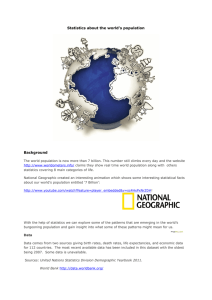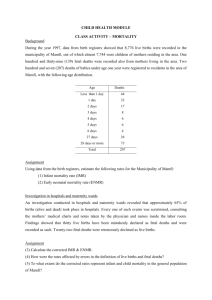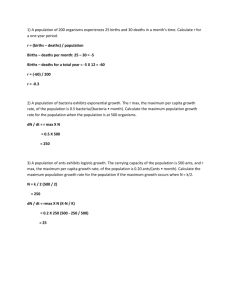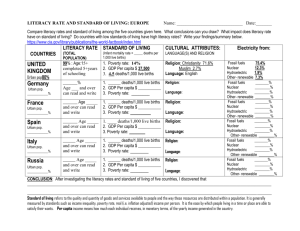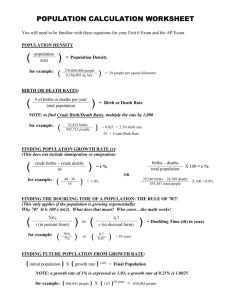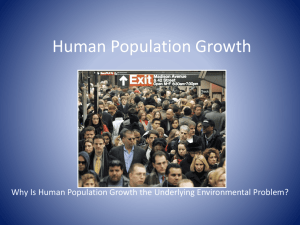Comprehensive Community and Home
advertisement
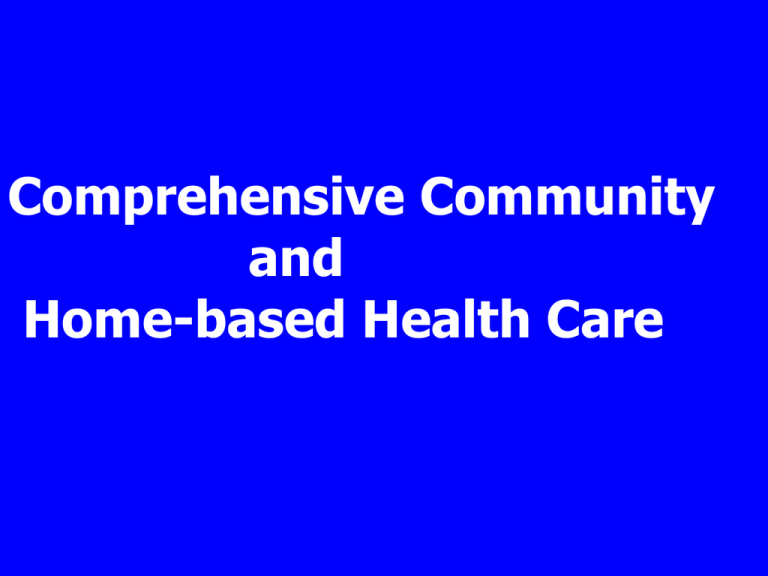
Comprehensive Community and Home-based Health Care Projected deaths in India 2010 Source: ICMR Tenth Plan documents Fig 2: Share in health care spending among the different sectors Source: National Health Accounts 2007, MoHFW India's Population 2011 Current Population of India in 2011 1,190,000,000 (1.19 billion) Age structure 0 to 25 years 50% of India's current population Currently, there are about 51 births in India in a minute. India's Population in 2001 1.02 billion Population of India in 1947 350 million •72.2% of the population lives in some 638,000 villages • 27.8% in about 5,480 towns and urban . • The birth rate 22.22 births/1,000 population (2009 est.) • Death rate is 6.4 deaths/1,000 population. Fertility rate is 2.72 children born/woman (NFHS-3, 2008) and Infant mortality rate is 30.15 deaths/1,000 live births (2009 estimated). India has the largest illiterate population in the world. The literacy rate of India as per 2001 Population Census is 65.38%, with male literacy rate at 75.96% and female at 54.28%. Kerala has the highest literacy rate at 90.86%, Mizoram (88.80%) is on the second position and Lakshadweep (86.66%) is on third. The model for comprehensive community- and home-based health care (CCHBHC) has been developed to ensure better accessibility to health and quality community health care. DEFINITION CCHBHC is defined as an integrated system of care designed to meet the health needs of individuals, families and communities in their local settings. GOAL • • • • Ensure better accessibility Effective and efficient health care To improve health and well-being Contribute to morbidity and mortality reduction OBJECTIVES • Promoting a healthy lifestyle and preventing illness • Managing the consequences • Serving the needs of the vulnerable and underprivileged • Supporting informal caregivers • Strengthening the community PRINCIPLES • Quality - structures and processes of care are organized to ensure that the care delivered is holistic, integrated and continuous, and in accordance with the agreed standards • Partnership -appropriate opportunities and methods are made available to enable and empower all stakeholders, and work in an honest and open PRINCIPLES contd. Equity - equitable access is ensured to all services and resources with a focus on the vulnerable and underprivileed groups. Effectiveness - special efforts are made to ensure that an intervention or service provided for the patient/client yields the intended result. Efficiency -optimal use is made of the range and mix of available resources (e.g. financial, human, physical and technical resources) in support of the delivery of evidence-based practice. STRATEGIES • • • • Political commitment and support Resources building Appropriate health information systems. Empowerment Figure 1. A conceptual framework of the model Implementation Approaches Implementation of the model in a country requires • National policy and support • Local action • Involvement of all stakeholders throughout the process • Initiation of small trials in selected areas to learn lessons • Evaluation of experiences and lessons learned for sustainable strategies • Coverage of and expansion to other areas CONCLUSION This model provides one response to improve the equity of, and accessibility to, quality health services within a local community. It includes a particular emphasis on involving all members of the community in identifying their needs and agreeing on priorities. It acknowledges the contribution made by those outside the formal health system to health and health care, and provides additional support. THE SEVEN WONDERS OF THE WORLD A group of students were asked to list what they thought were the present "Seven Wonders of the World." Though there were some disagreements, the following received the most votes: 1. Egypt's Great Pyramids 2. Taj Mahal 3. Grand Canyon 4. Panama Canal 5. Empire State Building 6. St. Peter's Basilica 7. China's Great Wall While gathering the votes, the teacher noted that one student had not finished her paper yet. So she asked the girl if she was having trouble with her list. The girl replied, "Yes, a little. I couldn't quite make up my mind because there were so many." The teacher said, "Well, tell us what you have, and maybe we can help". "The girl hesitated, then read: "I think the 'Seven Wonders of the World' are: 1. To See... 2. To Hear... 3. To Touch... 4. To Taste... 5. To Feel... 6. To Laugh... 7. And to Love." The room was so quiet you could have heard a pin drop. The things we overlook as simple and ordinary and that we take for granted are truly wondrous! A gentle reminder : That the Most precious things in life cannot be built by hand or bought by man. Iguassu Falls, BrazilLO



